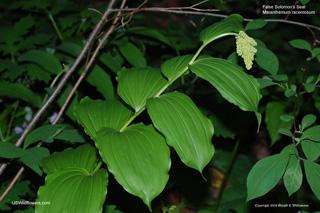False Solomon’s Seal, which has the “official” national common name of Feather False Solomon Seal, was listed in my old wildflower guide, the one I used when I first photographed and identified this plant five years ago, as Smilacina racemosa. I’ve subsequently discovered that classification has changed.
I’ve subsequently discovered that all the species in the entire Smilacina genus was reclassified into the Maianthemum (Mayflower) genus, and is now named Maianthemum racemosum. Not only was S. racemosa rolled into the M. racemosum genus, so were several other Smilacina species – S. amplexicaulis, S. ciliata, and S. flexicaulis. S. racemosa was an eastern U.S. species; S. amplexicaulus was a western species, and between the two of them, M. racemosum is found in every state except Hawaii.
M. racemosum is divided into two subspecies now, ssp. amplexicaule and ssp. racemosum. The former is the western subspecies, while ssp. racemosum is the eastern subspecies. According to the Flora of North America site referenced in the USDA Plants Database, the primary difference between the two subspecies are the leaf attachment, with M. racemosum ssp. amplexicaule being sessile and clasping, while M. racemosum ssp. racemosum has short petioles. Subspecies amplexicaule also is more erect, while subspecies racemosum is more arched. The photo below is of the eastern subspecies, and those a very short petioles, and the petioles themselves appear to be slightly decurrent, nearly giving the appearance of clasping, sessile leaves.
As of this date, all photos in the USWildflowers.com database are of the racemosum subspecies, since they are all from the eastern part of the United States. However, since the species with the new classification is found in all states except, the database has been updated to reflect that species presence. You can view more information, photos, and distribution map at the False Solomon Seal detail page.

